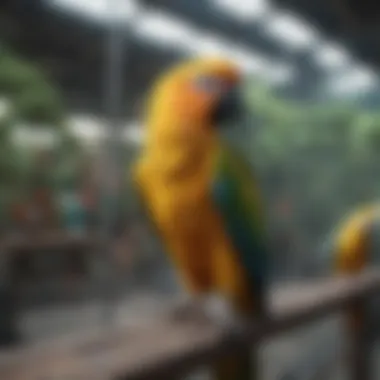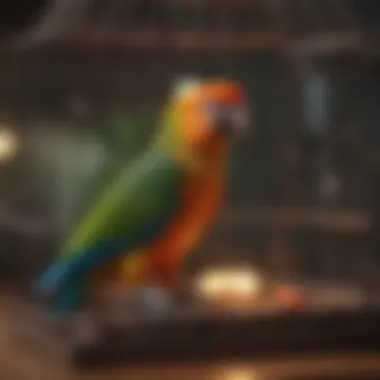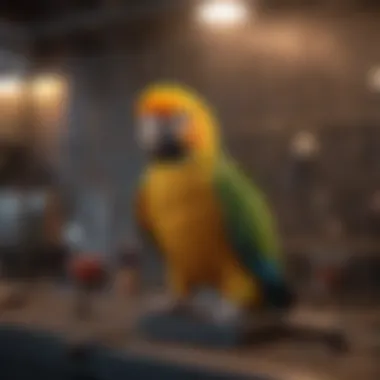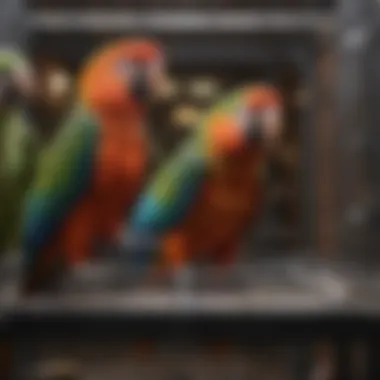Key Factors to Consider for Parrot Big Cages


Intro
Choosing an appropriate cage for your parrot is not just about aesthetics; it requires thorough thought and research. The size of the cage directly affects the health and well-being of your feathered companion. Cage selection goes beyond mere dimensions and involves understanding how your bird interacts with its environment. Size is essential, but so are the features and arrangement of the cage. The goal is to create a nurturing and safe habitat that caters to your parrot's needs.
A spacious cage promotes exercise, social interaction, and mental stimulation, all of which are vital components for a parrot's health. Different species of parrots have varied requirements, so it is worthwhile to know their unique habits and environments even before selecting a cage.
The phrase
Prelude to Parrot Housing
When considering the needs of parrots, housing becomes a critical factor affecting their well-being. Opening the cage, providing space, and having a stimulating environment goes beyond aesthetics. It improves health and suitability for natural behaviors. Poor housing can lead to physical distress and issues in behavior. Thus, understanding proper housing arrangements is essential for any hopeful parrot owner or breeder.
Importance of Proper Housing
The significance of providing proper housing for parrots cannot be understated. Unlike other pets, parrots are intelligent, social creatures. They require ample space to move around and engage in their natural behaviors. Well-designed cages prevent stress, aggression, and psychological problems that can arise from being confined in too small a space.
- Some specific reasons include:
- Physical Health: Sufficient room allows parrots to fly, exercise their muscles, and maintain a healthy weight.
- Behavioral Needs: Parrots need to climb, explore and enable social interactions. Proper housing accommodates these instincts.
- Nesting and Resting Space: It is critical for all parrots to have adequate options for rest and shelter. This enhances their feelings of safety.
When housing parrots, it's indispensable to respect their unique requirements while also promoting proper hygiene and maintenance. Inadequate housing can hinder a parrot's overall quality of life, leading to further complications in care.
Understanding Parrot Behavior
In understanding parrot behavior, one must recognize that these birds are social and highly adaptable. They communicate and establish relationships through various sounds and postures. Recognizing these characteristics aids in creating a supportive environment.
Habits in parrots stem from their wild ancestors. They tend to flock, play, and engage socially. Even in captivity, they maintain some of these instinctive actions. Key prefixes to grasp are:
- Social Interaction: Parrots thrive in environments that allow them to bond, both with their owners and other birds.
- Curiosity: Their natural instinct is to investigate and interact with their surroundings.
- Communication: These birds talk and communicate with body language. Recognizing their cues may signal if they feel comfortable in their environment.
Ultimately, housing must cater to and encourage these behaviors. This ensures they continue to engage socially and physically, leading to happier, healthier birds. Providing enriched housing spaces leads to enhancing their quality of life significantly.
Benefits of Big Cages
Selecting an appropriate cage is pivotal for the health of your parrot. Big cages offer significant advantages that influence both physical and mental well-being. Understanding these benefits can aid in making a more informed choice. Big cages enable parrots to engage in natural behaviors and foster an enriched environment, key for their development and enjoyment of life.
Enhanced Mobility and Exercise
A larger cage naturally provides more space for parrots to fly and move around. An area that allows for increased mobility gives parrots the chance to exercise in ways that smaller enclosures cannot. Consistent movement helps prevent obesity, a common issue in household birds bred in captivity. It is important to understand the flying and climbing behavior of different parrot species. For instance, large species such as Macaws thrive in expansive spaces more than smaller ones like Parakeets.
By incorporating horizontal and vertical space in the enclosure, owners motivate their birds to explore and get some physical activity. Additionally, the non-linear design can challenge their agility, making exercise enjoyable. Allowing them the chance to expend energy in a designated area is vital as it keeps their bodies strong, which also contributes to longer lifespans.
Improved Mental Health
Parrots are intelligent creatures and need engagement to keep their minds sharp. A big cage provides the room for a variety of toys and play structures, essential in keeping their cognitive functions engaged. Mental stimulation involved with discovery, play, and exploration aids in preventing boredom and associated behavioral issues like feather plucking or screaming.
Furthermore, having adequate space encourages socialization among feathered shapes, which is critical for species that thrive in flocks. Research has shown a clear connection between environmental complexity and mental well-being in pet birds. As these parrots interact with better stimuli, their stress levels notably decrease. Recognizing the rank behavior learned in flocks can drastically influence how well birds perform in sole living.
Social Interaction Opportunities
Cages that accommodate valuable space encourage not just bird-to-bird interaction, but also enhance engagement with owners. Birds enjoy companionship. Hence, offering an ideal habitat enriches this bond. Social interaction becomes easier in a spacious cage where toys and perches can be placed in various segments. Each object can invite exploration and add dynamics in play.


It's important for bird owners to spend quality time with their pets in the cage to encourage bond strengthening. Watch how your birds engage with the space can provide fitness and health rewards. When both social and spatial needs overlap, the results offer a heightened relational form—one centered around care and play. Having a big cage ensures its occupants remain active, both physically and socially—elements vital for overall happiness.
A spacious living environment supports both the longevity and quality of life for parrots, hence it is essential to prioritize their sizing during selection.
Overall, embracing the significance of what a big cage provides can immensely benefit your pet's health. Informed decisions can foster an environment that best replicates their natural habitats and behaviors stimulating solo or socially enriched experiences among your remarkable companion.
Choosing the Right Dimensions
Choosing the correct dimensions for a parrot's cage is essential. It greatly influences the bird's well-being and overall quality of life. Parrots are active, social birds that need space to move around. A cramped cage can lead to stress, behavioral problems, and health issues. By understanding the proper dimensions required for different species, bird owners can ensure their pets thrive in a comfortable environment.
Recommended Sizes for Different Parrots
Various parrot species have distinct requirements when it comes to cage sizes. Small parrots like budgerigars benefit from a cage that is at least 24 inches wide, 18 inches deep, and 24 inches high. For medium parrots, such as cockatiels, a cage measuring at least 30 inches wide, 24 inches deep, and 30 inches high is advisable. Larger species, including macaws, require even more space. A cage for a macaw should ideally be at least 48 inches wide, 36 inches deep, and 60 inches high.
The minimum cage size is just a starting point. Investing in a larger cage wherever possible can enhance the parrot’s experience.
Avoid cages that are too narrow or tall without ample horizontal space; these can inhibit natural behaviors such as flying and climbing. The general rule is: bigger is better. Additionally, the total volume matters, as sufficient space allows for enrichment items, contributing to a happier and healthier bird.
Factors Influencing Cage Size
When deciding on the size of a cage, several factors come into play. Understanding these elements will help in selecting the best possible habitat for your parrot.
- Species Type: The bird species significantly impacts size requirements. Larger birds need larger cages, while smaller ones may fit in more compact spaces.
- Activity Level: Consider how active your parrot is. Some breeds are more prone to needing larger spaces for exercising and playing.
- Socialization Needs: If your parrot enjoys interacting with multiple toys or other birds, it may require additional space than suggested minimums.
- Living Environment: The placement of the cage matters. If it is located in an area where space is limited, adjustments may be necessary.
Getting the dimensions right is more than just a number. It is about enabling a happy and fulfilling life for your feathered companion.
Essential Features of Big Cages
When it comes to the well-being of parrots, the importance of the essential features found in big cages cannot be overstated. These elements will play a vital role in creating a healthy and enriching environment for your feathered companion. Key characteristics, such as material, accessibility, and design, have significant influence over your parrot’s physical and psychological well-being.
Bar Spacing and Material Considerations
Bar spacing is a crucial factor when selecting a cage for your parrot. It affects both safety and comfort. If the spacing is too wide, your parrot might escape, or worse, get caught and potentially harmed. Generally, for small to medium-sized parrots like budgerigars and lovebirds, a spacing of 0.5 to 0.75 inches is suitable. Larger parrots, such as African greys or macaws, require spacing of at least 1 inch or more.
The materials from which the cage is constructed also deserve attention. Stainless steel is often recommended because it is durable and non-toxic. Avoid cages with coatings that can peel off, as this may introduce harmful chemicals. Choosing the right quality ensures long-term health for your pet while providing peace of mind for the owner.
Accessibility and Design
Accessibility in a big cage is vital for both the pet and the owner. Doors should be large enough for easy access to your parrot. A well-designed cage makes routine activities effortless, such as feeding and cleaning. Simpler access helps build a trusting relationship between you and your bird. Since parrots can be curious, also consider watch perches located near the doors.
Design matters in more ways than one. A cage with a variety of levels and branches provides opportunities for climbing and exploration. Maintaining physical activity is important for healthy bones and muscle growth, especially in smaller species. Furthermore, the interior layout encourages natural behaviors and provides mental stimulation, something essential in a bird's social development.
Removable Bases for Easy Cleaning
Cleanliness is si important but importn detail. Removable bases make it easier to keep the cage fresh. Regular cleaning is essential to prevent any health issues caused by bacteria and waste accumulation. The ability to remove the base simplifies the process. It allows for swift and thorough cleaning without disturbing your parrot more than necessary.
Having a clean environment not only prevents smell but also decreases germs. Additionally, looking for cages that come with non-absorbent and non-toxic materials is optimal for enhanced ease when cleaning. Small details, such as drop-down trays, can aid in a quicker maintenance routine.
"A big cage equipped with essential features supports not just the comfort but also the performance of a parrot’s daily behaviors."
Combining all these critical elements ultimately creates a haven where parrots can thrive. As you consider these features, keep in mind how they align with your specific needs as a bird owner to enhance the vivacity of your avian companion.


Cage Placement and Environment
Cage placement and environment play a critical role in the well-being of parrots. A bird’s surroundings greatly influence its health, happiness, and behavior. Choosing the right location for your parrot's cage can enhance its quality of life. It is essential to consider various elements like ambient conditions, visibility, and safety when deciding on cage location. Making informed placement choices ensures that your parrot feels secure and stimulated in its home.
Optimal Locations for Big Cages
The optimal location for a big cage can vary based on the specific needs of your parrot. A few considerations for placing the cage include:
- Central Area: Placing the cage in a communal area, like the living room, helps your parrot feel included in household activities. It encourages interaction with family members while allowing the bird to observe its environment.
- Away from Direct Sunlight: Ensure that your cage is not directly exposed to sunlight for extended periods. Overheating can be detrimental to a parrot's health.
- Height Consideration: Parrots instinctually prefer elevated spots. It's beneficial to place the cage at a height that allows your feathered friend to feel secure and less vulnerable.
Cage Enrichment Strategies
Cage enrichment strategies are essential for creating a stimulating and fulfilling environment for parrots. Every parrot is active, inquisitive, and social and thrives when offered opportunities to engage with their surroundings. Enrichment reduces boredom, encourages physical exercise, and fosters mental stimulation, which culminates in healthier and happier birds.
Toys and Climbing Structures
Toys and climbing structures are vital for keeping parrots engaged. Foraging puzzles, bells, and swings are only a few examples of how a cage can be made more appealing. Parrots enjoy toys that they can chew, discard, and manipulate. Climbing structures offer opportunities for recreational movement, allowing them to explore different areas within the cage.
- Benefits:
- Keeps the bird physically active.
- Provides mental challenges, helping develop problem-solving skills.
- Can serve individual personalities; different species prefer different types of interactions.
When selecting toys, consider rubber or unscented wood varieties that are safe. Rotate toys frequently to sustain their interest
Foraging Opportunities
Foraging opportunities simulate a bird's natural behavior by encouraging them to seek food. This promotes essential mental stimulation for parrots and helps to enrich their environment. An engaged parrot is less likely to develop behavior problems such as excessive screeching or feather plucking.
- Types of Foraging Crafts:
- Hiding treats within bedding.
- Using foraging toys that dispense rewards after manipulation.
- Hiding food in a designated area, but require exploration.
By constructing specific foraging activities, you become an integral part of your parrot's daily routine that can lower stress and build stronger bonds.
Social Interaction with Owners
Social interaction with owners is one of the most rewarding ways to enrich a bird's life. Periods of interaction, whether chatting, careful training, or simply being nearby are crucial. This shared time strengthens the psychological bond and creates a trustful rapport.
- Key aspects of social interaction:
- Regular engagement rituals such as whistles or dances.
- Shared activities that include teaching simple tricks or games.
- Demonstrating care by observing your bird's health.
Enriching the environment needs to consider not only the cages but also how you position yourself as an owner and partner fw these lovely winged creatures. This leads to fulfilling life for both birds and owners.
Common Misconceptions about Big Cages
Understanding common misconceptions about big cages for parrots is crucial. These beliefs can impact pet owners' decisions in providing the best enviroment for their birds. Misunderstandings about space requirements can harm the quality of life for the parrot and create friction between the owner and their bird. Dispel these misconceptions to ensure a safe, happy, and healthy home for your feathered companions.
Big Cages Prevent Bonding
One of the most prevalent errors is the idea that having a large cage hinders the bond between a parrot and its owner. In reality, spacious cages do not restrict interactions; they enhance them. When a parrot has room to move, it becomes more confident. Confidence translates to increased curiosity and willingness to interact. Therefore, providing a bigger cage actually allows the owner to spend more time with the bird since it feels comfortable exploring and engaging in various activities.


Behavioral studies show that parrots kept in suitable environments, which include larger spaces, tend to be more social. They have the opportunity to develop problem-solving skills, making interactions with owners more enriching. This attributed bonding is significantly more meaningful compared to birds confined to small spaces, who might become stressed or irritable.
Even more importantly, the spacious areas where a bird can fly or play enrich the activity level and help form bonds through engaging play sessions. Thus, optimally-sized cages may foster stronger connections, not hinder them.
Cages as a Form of Confinement
Another common myth is that big cages serve mainly as confinement. Many associate a cage with imprisonment; however, it should be seen differently. An adequately sized cage is simply a safe haven. It serves a purpose for the welfare of the parrot by providing a controlled environment. Cages become a private sanctuary where a parrot can retreat to relax without external disturbances.
It is essential to recognize that while parrots are social beings, they still need their safe spaces to unwind. A well-constructed cage offers not only living space but also a place for birds to engage with their toys, climb, and exercise without risk of outside dangers. Rather than being a limitation, big cages introduce an element of exploration. Mígrating from perches to play areas promotes physical health and emotional stability among parrots.
In those quarters, having toys and food located throughout the cage encourages natural behavior, thus enhancing the bird's quality of life.
To sum up, it is crucial to dismantle these misconceptions. Seeing extended cages as tools to allow bonding and safe spaces changes the perspective about housing parrots. They are not merely objects, but rich habitats necessary for flourishing within captivity.
Maintaining Big Cages
Maintaining big cages is essential for the well-being of parrots. Proper upkeep ensures a healthy and safe environment. Regular maintenance helps prevent disease spread, odors, and general discomfort for your pets. When properly maintained, a cage can provide a refuge that promotes overall happiness. Conversely, neglecting maintenance risks compromising the bird's health and could ultimately influence its behavior and mood negatively.
Regular Cleaning Protocols
Cleaning a parrot's cage is not merely a chore; it is a vital part of providing proper care. Regular cleaning minimizes the risk of bacteria, mold, and parasites that can build up in various areas of the cage. It is recommended to perform daily spot cleaning by removing soiled food and droppings. However, a more thorough cleaning should occur weekly.
For these comprehensive cleanings:
- Remove all toys and perches.
- Take out the food and water containers.
- Sweep or vacuum debris from the bottom.
- Clean surfaces with safe, bird-friendly cleaning solutions.
- Rinse and dry thoroughly before placing any items back.
Moreover, regularly inspect heavy usage areas, as these typically accumulate waste faster. Keeping everything clean creates a healthier environment for both your birds and yourself. Observation during cleaning can also detect signs of stress or illness.
Health Checks and Observations
Health checks are another layer to maintaining a cage. While the focus is often on cleanliness, monitoring the bird's condition allows for early intervention when issues arise. Every time you clean the cage, take notice of your parrot's behavior and physical state.
Several factors to observe include:
- Feather condition – Look for molting or feather loss.
- Activity level – A lack of interest in play or socializing could be concerning.
- Eating and drinking habits – Changes might indicate health issues.
Establishing a routine for checks makes health monitoring more manageable. Over time, pet owners may notice the patterns of their bird's behavior, permitting detection of significant changes that would otherwise go unregistered.
Regular maintenance promotes both the physical and mental health of your parrots, making them not only live longer but enjoy their environments far more.
Overall, remember, maintaining big cages for parrots involves dedication and consistency. Your effort reflects directly on the quality of life for your feathered companion.
Epilogue and Next Steps
Understanding the implications of proper housing for parrots is critical once we integrate everything discussed in this article. The choices you make when selecting a big cage can drastically impact the well-being of your feathered companion. Following the suggestions outlined regarding benefits, necessary sizes, design features, and the consideration of enriched environmental factors ensures your parrot makes the most of their space.
It is vital to reflect on the key points shared earlier. You must understand that a bigger cage promotes not just mobility but also essential mental stimulation. Additionally, a focus on proper placement takes into account light, temperature, and position away from danger. The articles on flaw misconceptions emphasize that an expansive environment nurtures bonds rather than deters them. Ensuring regular maintenance allows for a clean and safe space for play and rest.
Incorporating these essential points paves a pathway to implementing practical steps moving forward. Consider intermittent health checks, evaluating enrichment strategies, and investing time in interaction with your parrots. Each of these elements converges into one greater goal: the long-lasting happiness and flourishing health of your bird.
Summary of Key Points
- Importance of Size: A bigger cage offers larger living space enhancing exercise and mental health.
- Safety and Comfort: Appropriately place the cage in quiet spots, away from extremes in light and temperature.
- Health Protocols: Regular health checks and maintenance of cage, alongside interaction opportunities, establish a nurturing environment.
- Balanced Misconceptions: Understanding that cages do not obstruct bonding but rather aid in developing strong relationships.
Resources for Further Reading
For further depth on creating a better living environment for your parrots:
- The importance of appropriate behaviors and housing can be reviewed at Wikipedia.
- More on bird enrichment strategies can be explored through articles on Britannica.
- Participate in discussions within the bird enthusiast community at Reddit.
- Connect with groups focused on aviculture on Facebook.















